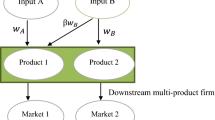Abstract
Cross-supplies describe the phenomenon that two or more firms in the same industry supply each other with their final products. A prominent example is the cooperation in the European flat-glass industry, which was recently criticized by the European Commission. In a simple model we attempt to explain what incentives firms may have to use cross-supplies (instead of producing the goods themselves) and what welfare effects cross-supplies have if they are used. Contrary to the ruling of the European Commission we find that cross-supplies improve welfare whenever they are employed. Furthermore, for a large range of parameters, they even benefit consumers.
Similar content being viewed by others
References
Auerbach, A. (1985): “The Theory of Excess Burden and Optimal Taxation.” InHandbook of Public Economics, edited by A. Auerbach and M. Feldstein. Amsterdam: North-Holland.
European Court of Justice (1992): “Judgement of the Court of First Instance of 10 March 1992 in Joined Cases: T-68/89, T-77/89 and T-78/89. Societa Italiana Vetro SpA et al.”Official Journal of the EEC C107/8.
EEC Commission (1989): “Decision of 7 December 1988 Relating to a Proceeding under Articles 85 and 86 of the EEC Treaty (IV/31.906, Flat Glass).”Official Journal of the EEC L 33/44, 04.02.1989.
Harsanyi, J., and Selten, R. (1988):A General Theory of Equilibrium Selection. Cambridge, Mass.: MIT Press.
Kamien, M., Li, L., and Samet, D. (1989): “Bertrand Competition with Subcontracting.”Rand Journal of Economics 20: 553–567.
Krishnan, M., and Röller, L. (1993): “Preemptive Investment with Resalable Capacity.”Rand Journal of Economics 24: 479–502.
Lawrence, R. (1993): “Japan's Different Trade Regime: an Analysis with Particular Reference toKeiretsu.”Journal of Economic Perspectives 7: 3–19.
Matsumura, T. (1997): “A Two-Stage Cournot Duopoly with Inventory Costs.”Japanese Economic Review 48: 81–89.
Salinger, M. (1988): “Vertical Mergers and Market Foreclosure.”Quarterly Journal of Economics 103: 345–356.
Saloner, G. (1987): “Cournot Duopoly with Two Production Periods.”Journal of Economic Theory 42: 183–187.
Schrader, A., and Martin, S. (1998): “Vertical Market Participation.”Review of Industrial Organization 13: 321–331.
Spiegel, Y. (1993): “Horizontal Subcontracting.”Rand Journal of Economics 24: 570–590.
Author information
Authors and Affiliations
Rights and permissions
About this article
Cite this article
Baake, P., Oechssler, J. & Schenk, C. Explaining cross-supplies. Zeitschr. f. Nationalökonomie 70, 37–60 (1999). https://doi.org/10.1007/BF01226143
Received:
Revised:
Issue Date:
DOI: https://doi.org/10.1007/BF01226143



